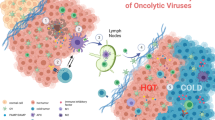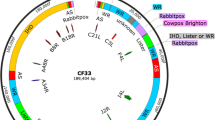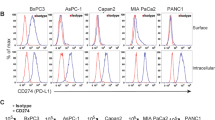Abstract
Pancreatic cancer is a significant clinical problem and novel therapeutic approaches are desperately needed. Recent advances in conditionally replicative adenovirus-based (CRAd) oncolytic virus design allow the application of CRAd vectors as a therapeutic strategy to efficiently target and eradicate chemoresistant pancreatic cancer cells, thereby improving the efficacy of pancreatic cancer treatment. The goal of this study was to construct and validate the efficacy of an infectivity-enhanced, liver-untargeted, tumor-specific CRAd vector. A panel of CRAds has been derived that embodies the C-X-C chemokine receptor type 4 promoter for conditional replication, two-fiber complex mosaicism for targeting expansion and hexon hypervariable region 7 (HVR7) modification for liver untargeting. We evaluated CRAds for cancer virotherapy using a human pancreatic tumor xenograft model. Employment of the fiber mosaic approach improved CRAd replication in pancreatic tumor xenografts. Substitution of the HVR7 of the Ad5 hexon for Ad serotype 3 hexon resulted in decreased liver tropism of systemically administrated CRAd. Obtained data demonstrated that employment of complex mosaicism increased efficacy of the combination of oncolytic virotherapy with chemotherapy in a human pancreatic tumor xenograft model.
This is a preview of subscription content, access via your institution
Access options
Subscribe to this journal
Receive 12 print issues and online access
$259.00 per year
only $21.58 per issue
Buy this article
- Purchase on Springer Link
- Instant access to full article PDF
Prices may be subject to local taxes which are calculated during checkout





Similar content being viewed by others
References
Siegel R, Ma J, Zou Z, Jemal A . Cancer statistics, 2014. CA Cancer J Clin 2014; 64: 9–29.
Neesse A, Krug S, Gress TM, Tuveson DA, Michl P . Emerging concepts in pancreatic cancer medicine: targeting the tumor stroma. Onco Targets Ther 2013; 7: 33–43.
Lowery MA, O'Reilly EM . Genomics and pharmacogenomics of pancreatic adenocarcinoma. Pharmacogenomics J 2012; 12: 1–9.
Shah AN, Summy JM, Zhang J, Park SI, Parikh NU, Gallick GE . Development and characterization of gemcitabine-resistant pancreatic tumor cells. Ann Surg Oncol 2007; 14: 3629–3637.
Gourgou-Bourgade S, Bascoul-Mollevi C, Desseigne F, Ychou M, Bouche O, Guimbaud R et al. Impact of FOLFIRINOX compared with gemcitabine on quality of life in patients with metastatic pancreatic cancer: results from the PRODIGE 4/ACCORD 11 randomized trial. J Clin Oncol 2013; 31: 23–29.
Von Hoff DD, Ervin T, Arena FP, Chiorean EG, Infante J, Moore M et al. Increased survival in pancreatic cancer with nab-paclitaxel plus gemcitabine. N Engl J Med 2013; 369: 1691–1703.
Yamamoto M, Curiel DT . Cancer gene therapy. Technol Cancer Res Treat 2005; 4: 315–330.
Eager RM, Nemunaitis J . Clinical development directions in oncolytic viral therapy. Cancer Gene Ther 2011; 18: 305–317.
Tan BT, Park CY, Ailles LE, Weissman IL . The cancer stem cell hypothesis: a work in progress. Lab Invest 2006; 86: 1203–1207.
Dalerba P, Cho RW, Clarke MF . Cancer stem cells: models and concepts. Annu Rev Med 2007; 58: 267–284.
Li C, Heidt DG, Dalerba P, Burant CF, Zhang L, Adsay V et al. Identification of pancreatic cancer stem cells. Cancer Res 2007; 67: 1030–1037.
Abel EV, Simeone DM . Biology and clinical applications of pancreatic cancer stem cells. Gastroenterology 2013; 144: 1241–1248.
Zhu ZB, Makhija SK, Lu B, Wang M, Kaliberova L, Liu B et al. Transcriptional targeting of adenoviral vector through the CXCR4 tumor-specific promoter. Gene Ther 2004; 11: 645–648.
He TC, Zhou S, da Costa LT, Yu J, Kinzler KW, Vogelstein B . A simplified system for generating recombinant adenoviruses. Proc Natl Acad Sci USA 1998; 95: 2509–2514.
Krasnykh VN, Mikheeva GV, Douglas JT, Curiel DT . Generation of recombinant adenovirus vectors with modified fibers for altering viral tropism. J Virol 1996; 70: 6839–6846.
Kaliberov SA, Kaliberova LN, Hong LuZ, Preuss MA, Barnes JA, Stockard CR et al. Retargeting of gene expression using endothelium specific hexon modified adenoviral vector. Virology 2013; 447: 312–325.
Sirena D, Lilienfeld B, Eisenhut M, Kalin S, Boucke K, Beerli RR et al. The human membrane cofactor CD46 is a receptor for species B adenovirus serotype 3. J Virol 2004; 78: 4454–4462.
Short JJ, Vasu C, Holterman MJ, Curiel DT, Pereboev A . Members of adenovirus species B utilize CD80 and CD86 as cellular attachment receptors. Virus Res 2006; 122: 144–153.
Tuve S, Wang H, Ware C, Liu Y, Gaggar A, Bernt K et al. A new group B adenovirus receptor is expressed at high levels on human stem and tumor cells. J Virol 2006; 80: 12109–12120.
Wang H, Li ZY, Liu Y, Persson J, Beyer I, Moller T et al. Desmoglein 2 is a receptor for adenovirus serotypes 3, 7, 11 and 14. Nat Med 2011; 17: 96–104.
Parker AL, Waddington SN, Nicol CG, Shayakhmetov DM, Buckley SM, Denby L et al. Multiple vitamin K-dependent coagulation zymogens promote adenovirus-mediated gene delivery to hepatocytes. Blood 2006; 108: 2554–2561.
Shayakhmetov DM, Gaggar A, Ni S, Li ZY, Lieber A . Adenovirus binding to blood factors results in liver cell infection and hepatotoxicity. J Virol 2005; 79: 7478–7491.
Zinn KR, Szalai AJ, Stargel A, Krasnykh V, Chaudhuri TR . Bioluminescence imaging reveals a significant role for complement in liver transduction following intravenous delivery of adenovirus. Gene Ther 2004; 11: 1482–1486.
Alba R, Bradshaw AC, Parker AL, Bhella D, Waddington SN, Nicklin SA et al. Identification of coagulation factor (F)X binding sites on the adenovirus serotype 5 hexon: effect of mutagenesis on FX interactions and gene transfer. Blood 2009; 114: 965–971.
Alba R, Bradshaw AC, Coughlan L, Denby L, McDonald RA, Waddington SN et al. Biodistribution and retargeting of FX-binding ablated adenovirus serotype 5 vectors. Blood 2010; 116: 2656–2664.
Short JJ, Rivera AA, Wu H, Walter MR, Yamamoto M, Mathis JM et al. Substitution of adenovirus serotype 3 hexon onto a serotype 5 oncolytic adenovirus reduces factor X binding, decreases liver tropism, and improves antitumor efficacy. Mol Cancer Ther 2010; 9: 2536–2544.
Prados J, Alvarez PJ, Melguizo C, Rodriguez-Serrano F, Carrillo E, Boulaiz H et al. How is gene transfection able to improve current chemotherapy? The role of combined therapy in cancer treatment. Curr Med Chem 2012; 19: 1870–1888.
Xu C, Li H, Su C, Li Z . Viral therapy for pancreatic cancer: tackle the bad guys with poison. Cancer Lett 2013; 333: 1–8.
Takayama K, Reynolds PN, Short JJ, Kawakami Y, Adachi Y, Glasgow JN et al. A mosaic adenovirus possessing serotype Ad5 and serotype Ad3 knobs exhibits expanded tropism. Virology 2003; 309: 282–293.
Wehler T, Wolfert F, Schimanski CC, Gockel I, Herr W, Biesterfeld S et al. Strong expression of chemokine receptor CXCR4 by pancreatic cancer correlates with advanced disease. Oncol Rep 2006; 16: 1159–1164.
Hermann PC, Huber SL, Herrler T, Aicher A, Ellwart JW, Guba M et al. Distinct populations of cancer stem cells determine tumor growth and metastatic activity in human pancreatic cancer. Cell Stem Cell 2007; 1: 313–323.
Castellanos JA, Merchant NB, Nagathihalli NS . Emerging targets in pancreatic cancer: epithelial-mesenchymal transition and cancer stem cells. Onco Targets Ther 2013; 6: 1261–1267.
Ribacka C, Hemminki A . Virotherapy as an approach against cancer stem cells. Curr Gene Ther 2008; 8: 88–96.
Doronin K, Flatt JW, Di Paolo NC, Khare R, Kalyuzhniy O, Acchione M et al. Coagulation factor X activates innate immunity to human species C adenovirus. Science 2012; 338: 795–798.
Xu Z, Qiu Q, Tian J, Smith JS, Conenello GM, Morita T et al. Coagulation factor X shields adenovirus type 5 from attack by natural antibodies and complement. Nat Med 2013; 19: 452–457.
Wang H, Beyer I, Persson J, Song H, Li Z, Richter M et al. A new human DSG2-transgenic mouse model for studying the tropism and pathology of human adenoviruses. J Virol 2012; 86: 6286–6302.
Acknowledgements
We thank Cynthia L. Marich from the Biologic Therapeutics Center, Department of Radiation Oncology, School of Medicine, Washington University in St Louis for her assistance in preparing the manuscript. This work was supported in part by the National Institutes of Health under award number 5P50 CA101955.
Author information
Authors and Affiliations
Corresponding author
Ethics declarations
Competing interests
The authors declare no conflict of interest.
Rights and permissions
About this article
Cite this article
Kaliberov, S., Kaliberova, L., Buchsbaum, D. et al. Experimental virotherapy of chemoresistant pancreatic carcinoma using infectivity-enhanced fiber-mosaic oncolytic adenovirus. Cancer Gene Ther 21, 264–274 (2014). https://doi.org/10.1038/cgt.2014.26
Received:
Revised:
Accepted:
Published:
Issue Date:
DOI: https://doi.org/10.1038/cgt.2014.26
This article is cited by
-
Retargeted oncolytic adenovirus displaying a single variable domain of camelid heavy-chain-only antibody in a fiber protein
Molecular Therapy - Oncolytics (2015)



